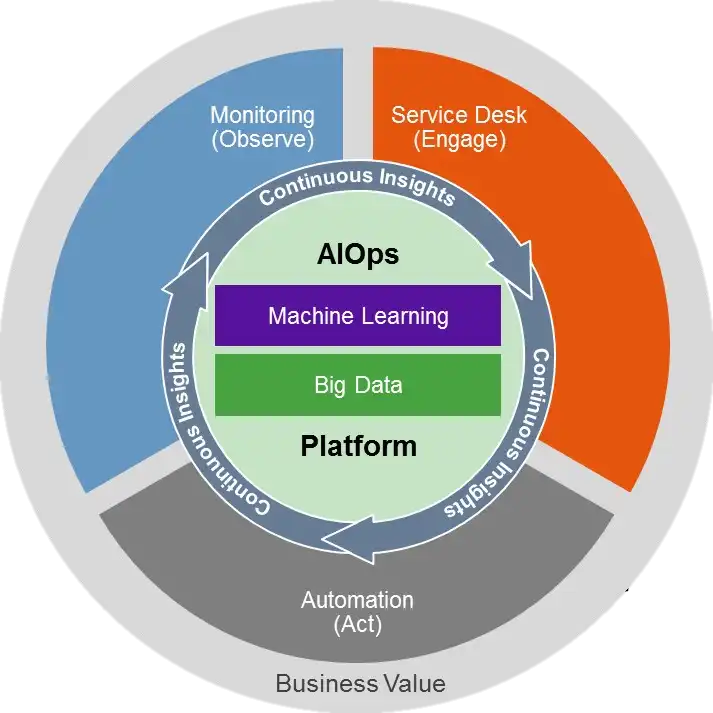August 2017 ushered in a new term heralded by Gartner in the form of AIOps: Artificial Intelligence for IT Operations. The term has certainly generated a lot of market hype, but what exactly is AIOps, and how can it help support your business operations?
Gartner’s official definition for AIOps is:
“AIOps platforms utilize big data, modern machine learning and other advanced analytics technologies to directly and indirectly enhance IT operations (monitoring, automation and service desk) functions with proactive, personal and dynamic insight. AIOps platforms enable the concurrent use of multiple data sources, data collection methods, analytical (real-time and deep) technologies, and presentation technologies.”
Artificial Intelligence for IT Operations

Source: Gartner – AIOps Platforms
IT Operations has rapidly and exponentially evolved over the past few decades to today where the amount of data involved with your application infrastructure is almost incomprehensible. Even more remarkable is that some organizations are still processing and reporting on this data manually using static reports designed decades ago. The need for constant availability and before-real-time insights is what has led us to AIOps. So how does applying Artificial Intelligence to IT Operations address issues presented to today’s IT teams?
Automates Data Collection, Processing, and Analysis from Multiple Sources
Artificial Intelligence enables an expert system to continually and automatically compile all the complex data about an IT infrastructure from multiple sources, compare it, rate it, and generate dynamic reports that can be used by human analysts to devise plans based on accurate intelligence. These capabilities include:
- Continuous, automated assessment of infrastructure performance risks
- Continuous, automated assessment of infrastructure cost-efficiency issues
- Adaptive ratings of performance metrics that vastly reduce false positives and false negatives
- Exception tables summarizing and prioritizing all identified issues even for very large sites
- Built-in recommendations that lead to understanding and resolving root causes of availability problems
- Intelligent correlation and normalization of the data for multi-dimensional navigation by users
This ability to derive detailed and accurate information out of the raw data with minimal false positives and false negatives is precisely what adds so much business value to IT teams.
Business Benefits of AIOps
Humans are not good at sorting through reams of data looking for elusive answers, but computers are. Rather than all this intelligence being hidden in a black box of data, the realization that we can now make predictive and accurate data-driven decisions allows the business to benefit from:
- Insights into workloads that drive costs: By understanding what is driving costs at what times and understanding hardware capabilities, costs can be optimized and avoided.
- Eliminating the skills gap: Easier access to data with built-in intelligence allows current experts to spend more time on key decisions and streamlines the learning process for newer members of the team.
- Provide application availability and eliminate customer frustration: Eliminate application slowdowns on even the busiest and highest transaction days.
- Avoid costly service disruptions and eliminate firefighting: Intelligence that alerts to key approaching issues allows them to be proactively avoided.
- Increase business responsiveness: Make data-driven decisions that allow your business to stay up to date with emerging trends.
Going forward, businesses will find it harder and harder to remain competitive with their performance by continuing to operate in an outdated and manual fashion. By applying artificial intelligence to IT operations in the performance and capacity discipline, problems are easier to understand, resolve, predict, and prevent. Better intelligence; better availability; better results.
This article's author
Share this blog
Related Resources
Challenging the Skills Gap – The Next Generation Mainframers | IntelliMagic zAcademy
Hear from these young mainframe professionals on why they chose this career path and why they reject the notion that mainframes are obsolete.
New to z/OS Performance? 10 Ways to Help Maintain Performance and Cost | IntelliMagic zAcademy
This webinar will delve into strategies for managing z/OS performance and costs. You'll gain insights into key metrics, learn how to identify bottlenecks, and discover tips for reducing costs.
What's New with IntelliMagic Vision for z/OS? 2024.2
February 26, 2024 | This month we've introduced changes to the presentation of Db2, CICS, and MQ variables from rates to counts, updates to Key Processor Configuration, and the inclusion of new report sets for CICS Transaction Event Counts.
Book a Demo or Connect With an Expert
Discuss your technical or sales-related questions with our mainframe experts today

 Morgan Oats
Morgan Oats